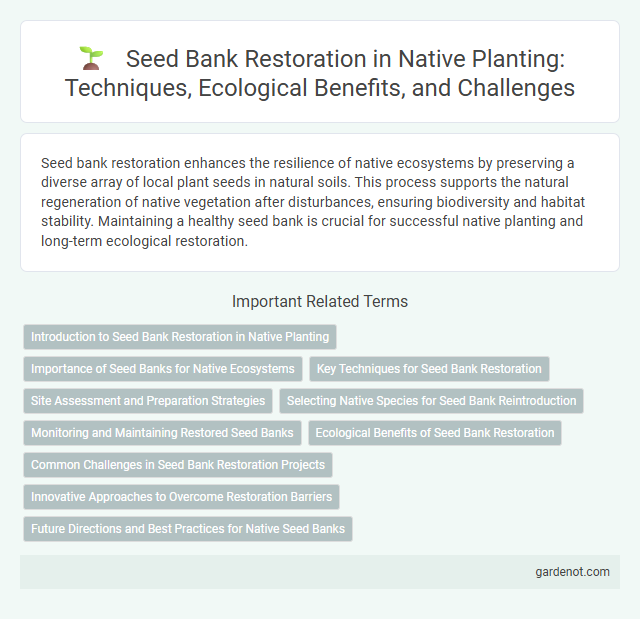Seed bank restoration enhances the resilience of native ecosystems by preserving a diverse array of local plant seeds in natural soils. This process supports the natural regeneration of native vegetation after disturbances, ensuring biodiversity and habitat stability. Maintaining a healthy seed bank is crucial for successful native planting and long-term ecological restoration.
Introduction to Seed Bank Restoration in Native Planting
Seed bank restoration in native planting involves revitalizing the natural reservoir of viable seeds within the soil to promote ecosystem recovery and biodiversity. This method supports the reestablishment of indigenous plant species by enhancing soil seed reserves through careful management and habitat protection. Effective seed bank restoration relies on understanding seed longevity, dormancy mechanisms, and the specific germination needs of native flora.
Importance of Seed Banks for Native Ecosystems
Seed banks play a crucial role in native ecosystem restoration by preserving genetic diversity essential for resilient plant populations. They provide a secure repository of native seeds, enabling restoration projects to access locally adapted species that support habitat stability and biodiversity. Maintaining seed banks ensures the recovery of endangered native plants and helps ecosystems withstand environmental changes and disturbances.
Key Techniques for Seed Bank Restoration
Key techniques for seed bank restoration include site preparation through soil disturbance to reduce existing vegetation and enhance seed-soil contact, ensuring favorable conditions for germination. Collecting and processing native seeds at optimal times preserves viability and genetic diversity, while stratification or scarification treatments break dormancy to promote seedling establishment. Incorporating a diverse mix of species supports ecosystem resilience and restores native plant community structure effectively.
Site Assessment and Preparation Strategies
Site assessment for seed bank restoration involves a detailed evaluation of soil composition, moisture levels, and existing native seed presence to determine restoration feasibility. Preparation strategies include removing invasive species, optimizing soil conditions through tilling or mulching, and timing seed sowing to align with natural germination cycles. These steps maximize seed viability and promote successful native plant establishment.
Selecting Native Species for Seed Bank Reintroduction
Selecting native species for seed bank reintroduction involves prioritizing locally adapted plants that enhance ecosystem resilience and biodiversity. Emphasizing genetic diversity within species ensures successful establishment and long-term ecological balance. Restoration efforts benefit from comprehensive surveys of regional flora to match seed banks with historically present native species.
Monitoring and Maintaining Restored Seed Banks
Effective monitoring and maintaining restored seed banks involves regular assessment of seed viability and biodiversity to ensure the long-term success of native plant populations. Employing germination tests and soil seed bank sampling helps track species composition and detect potential declines in seed density. Adaptive management based on monitoring data supports habitat restoration goals and strengthens ecosystem resilience.
Ecological Benefits of Seed Bank Restoration
Seed bank restoration enhances biodiversity by reintroducing native plant species adapted to local ecosystems, supporting habitat resilience and ecosystem stability. It promotes soil health through improved nutrient cycling and erosion control, fostering a balanced environment for flora and fauna. Restoring seed banks also aids in carbon sequestration, contributing to climate regulation and mitigating environmental degradation.
Common Challenges in Seed Bank Restoration Projects
Common challenges in seed bank restoration projects include maintaining seed viability during long-term storage and ensuring genetic diversity to support ecosystem resilience. Environmental variability and collection timing often affect seed quality, complicating germination success. Limited funding and resource allocation further constrain the capacity to monitor and manage seed banks effectively for native plant restoration.
Innovative Approaches to Overcome Restoration Barriers
Innovative seed bank restoration methods leverage cryopreservation and advanced germination protocols to enhance the viability of native plant seeds in degraded ecosystems. Techniques such as seed coating with microbial inoculants and hydrogel encapsulation improve water retention and pathogen resistance, increasing restoration success rates. Integrating genomics and remote sensing technology enables precise monitoring and selection of seed sources, optimizing restoration outcomes in challenging habitats.
Future Directions and Best Practices for Native Seed Banks
Future directions for native seed banks emphasize the integration of advanced genetic sequencing and data analytics to enhance seed viability and adaptability. Best practices include establishing regional collaborations for diverse seed sourcing, implementing rigorous storage protocols, and prioritizing local ecotype preservation to ensure ecosystem resilience. Continuous monitoring and adaptive management strategies support the restoration and conservation goals of native plant communities.
Seed bank restoration Infographic

 gardenot.com
gardenot.com